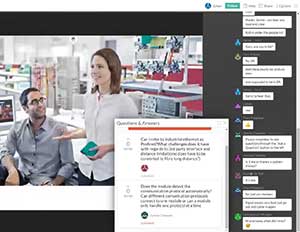

At the technology evening on Wednesday 1 July, Rob Burns from Pepperl+Fuchs presented on Ethernet Advanced Physical Layer (APL) and the concepts and implications for the IIoT, collaboration, applications and the various infrastructures available today.
Communication technology in offices and factory automation has become as commonplace as power cables. But, for a variety of reasons, Ethernet is not yet established in process automation, even though it is the ideal technology for transmitting large amounts of data, which is more important than ever for Industry 4.0 applications. Pepperl+Fuchs is working with other companies and user organisations to extend the benefits of Ethernet to the process industry.
APL will make it possible to connect field devices directly to Ethernet-based systems, and the network transitions that up to now have presented time-consuming configuration bottlenecks will no longer be required. An APL architecture is based on the use of switches that ensure compatibility with all common Ethernet protocols such as Profinet and EtherNet/IP. The ‘power switch’ is installed in the control room or in an on-site distributor. It establishes a connection between the field and standard Ethernet technology. Through two-wire cables of up to 1000 m flows not only data but also power, meaning the connected field devices are supplied with energy from the same cable. At field level, the field switch is connected in hazardous areas in an intrinsically safe manner via the field devices and two-wire cables of up to 200 m in length. This makes possible end-to-end, direct Ethernet communication from the control room to the field level and vice versa.
With a transfer rate of 10 Mbit/s, Ethernet is also nearly 10 000 times faster than HART and can thus handle significantly larger data quantities in Industry 4.0 applications. In addition to analysing data from field devices and sensors for predictive maintenance, Ethernet also simplifies the engineering, installation, and operation of field devices in process automation. In Pepperl+Fuchs’’ demonstrator, an Ethernet field device provides everything necessary for project planning and operation: configuration can be carried out via a web browser, while operating instructions and certificates are stored on the device and are directly available via download. With a scan, an asset management system can detect all connected devices and load the FDI device package directly from the device. The device can also communicate directly with the cloud via an integrated OPC/UA server. This means that all of a plant’s assets are shown in real time.
A big advantage of APL is that existing installations and infrastructures relied on by the process industry, with its typically long plant operating hours, can remain. This way, APL supports the trunk and spur technology that is established in process automation. It also specifies standard fieldbus cable, type A, so that plant operators can use their existing cabling to migrate. The field switch in Pepperl+Fuchs’ demonstrator also supports both field devices with an APL interface and conventional fieldbus devices. It automatically detects if a Profibus PA device is connected instead of an Ethernet field device. The switch can then adapt the baud rate and protocol to the corresponding port and convert the data to Ethernet. So step-by-step migration is already a part of the APL concept, which allows plant operators to enjoy the benefits of Ethernet communication and the wealth of information from field devices and sensors without having to completely rebuild their plants.
| Tel: | +27 11 312 2445 |
| Email: | ina@saimc.co.za |
| www: | www.saimc.co.za |
| Articles: | More information and articles about SAIMC |
© Technews Publishing (Pty) Ltd | All Rights Reserved